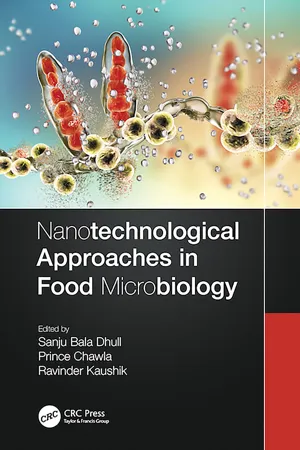
Nanotechnological Approaches in Food Microbiology
- 468 pages
- English
- ePUB (mobile friendly)
- Available on iOS & Android
Nanotechnological Approaches in Food Microbiology
About This Book
Nanotechnology has gained attention in all aspects of modern science, having vital applications in the food chain, storage, quality monitoring, processing, preservation, and packaging. The global population is increasing rapidly, therefore there is a requirement to produce food products in a more proficient, non-toxic, and sustainable way. Food scientists and microbiologists are interested in food safety and quality assurance to produce excellent-quality food free of food pathogens
Nanotechnological Approaches in Food Microbiology provides a systematic introduction and comprehensive information about practical approaches and characteristic features related to the significant applications of nanotechnology in food microbiology, including, nano-starch films, nanoemulsions, biogenic nanoparticles, and nanocapsules. The book will explore details about metal nanoparticle synthesis, characterization, mathematical modeling, kinetic studies, and their antimicrobial approaches.
Key Features:
-
- Includes comprehensive knowledge on metal nanoparticle synthesis, characterization, mathematical modeling, kinetic studies and their antimicrobial approaches
-
- Lays out concepts of essential oil nanoemulsion and their potential antimicrobial applications
-
- Deals with the latest development in nano-starch composite biofilms containing bioactive constituents to inhibit pathogenic microbes
-
- Explores the nanocapsules as potential antimicrobial agents in food.
-
- Provides information regarding new biogenic nano-antimicrobials developed for the food safety and quality assurance
This book will educate readers on the aspects of nanotechnology in food safety and quality assurance. Nanoemulsions, nanohydrogels, metal nanoparticles, nano-starch films, nanocapsules and nano-antimicrobials are the emerging essentials of nanotechnology that are used to preserve the food at greater extent. This book should be of interest to a large and varied audience of researchers in academia, industry, food processing, preservation, packaging, microbiology and policy regulations.
Frequently asked questions
Information
1Mathematical Models and Kinetic Studies for the Assessment of Antimicrobial Properties of Metal Nanoparticles
CONTENTS
1.1Introduction
Table of contents
- Cover
- Half Title
- Title Page
- Copyright Page
- Table of Contents
- Preface
- About the Editors
- List of Contributors
- List of Abbreviations
- Chapter 1: Mathematical Models and Kinetic Studies for the Assessment of Antimicrobial Properties of Metal Nanoparticles
- Chapter 2: Mushroom Extract–Reduced Metal Nanoparticles: An Effective Approach Against Food Pathogenic Bacteria
- Chapter 3: Antimicrobial Efficacy of Neem Extract–Stabilized Metal Nanoparticles
- Chapter 4: Metal Nanoparticles of Microbial Origin and Their Antimicrobial Applications in Food Industries
- Chapter 5: A Way Forward With Nano-Antimicrobials as Food Safety and Preservation Concern: A Look at the Ongoing Trends
- Chapter 6: Biogenic Nanoparticles: A New Paradigm for Treating Infectious Diseases in the Era of Antibiotic Resistance
- Chapter 7: Nanoparticles and Antibiotic Drug Composite: A Novel Approach Towards Antimicrobial Activity
- Chapter 8: Nanoemulsions of Plant-Based Bioactive CompoundsSynthesis, Properties, and Applications: Synthesis, Properties, and Applications
- Chapter 9: Essential Oil Nanoemulsions: As Natural Antimicrobial Agents
- Chapter 10: Nanoemulsions Formulated With Cinnamon Oil and Their Antimicrobial Applications
- Chapter 11: Applications, Formulations, Antimicrobial Efficacy, and Regulations of Essential Oils Nanoemulsions in Food
- Chapter 12: Antimicrobial Efficacy of Essential Oil Nanoemulsions
- Chapter 13: Nanotechnologies in Food Microbiology: Overview, Recent Developments, and Challenges
- Chapter 14: Nanocapsules as Potential Antimicrobial Agents in Food
- Chapter 15: Nano-Starch Films as Effective Antimicrobial Packaging Material
- Chapter 16: Starch Bio-Nanocomposite Films as Effective Antimicrobial Packaging Material
- Chapter 17: Biogenic Metal Nanoparticles and Their Antimicrobial Properties
- Chapter 18: Enhanced Antimicrobial Efficacy of Essential Oils–Based Nanoemulsions
- Chapter 19: Nano-Starch Films as Effective Antimicrobial Packaging Materials
- Index